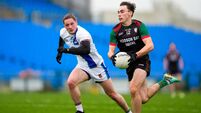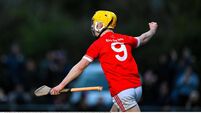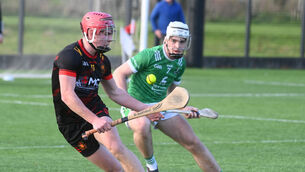Hurling Hands: Jill Horan - I never took to the plastic hurleys — the touch wasn't the same


My hands are pretty okay — I broke a couple of fingers back in the day, but no surgery needed.
I got a few stitches over the eye one time when a hurley came in through the facemask, but in general I’d have been known for being on the periphery, looking for the breaking ball.
When I was playing I had the usual scrapes and cuts but one difference between hurling and camogie is the hoops on a hurley are taped over in camogie, so that helps — there aren’t as many cuts.
I was reared in America until I was ten, and then we came back to my father’s family area, Drangan in Tipperary. In America my brother, sister and I played tennis — my parents were big into tennis — as well as baseball. That helped with the hand-eye co-ordination, but when we moved home we held the hurley like a baseball bat, the ‘wrong’ way, like a golf grip.
Our school principal, William O’Grady, who played for Tipperary himself, hounded us into changing our grip — though my sister never did — and as a result it was sixth class in school before I got to grips with that changed grip, with holding the hurley the opposite way to how I’d started.
I wouldn’t say it was that challenging: it was just a bit strange for a while, but my brother and I practiced away, hitting the ball off the wall, and we got the hang of it.

I was a bit precious with my hurleys — Jimmy O’Brien in Drangan made them when I was growing up, but then I used Torpey hurlers. A good friend of mine, Peter Maher, worked for Torpey’s and would have gotten hurlers for me.
I liked my hurleys light, around 31 or 32 inches. Starting off in my career I liked a very light hurley because I was inside corner-forward, but as I moved outfield towards midfield I switched to a heavier hurley because I needed to deliver the ball a bit further, obviously.
When I moved to Dublin I fell in with Ballyboden St Enda’s for training for a couple of years, and the plastic hurleys were huge at that time, a lot of girls used them and swore by them.
I never really took to them, to be honest. I tried one for a couple of training sessions and found the touch too strong — the ball would bounce too far off the plastic compared to the touch you’d get with the traditional stick.
I’d have to use the same hurley and would usually have three: two I’d be comfortable with and one then as a back-up if it came to it.
When it comes to skills, I first came onto the scene with Tipperary as a kid and was fascinated with how Deirdre Hughes was able to catch the ball over defenders, because she wasn’t that tall.
Another difference between camogie and hurling is that you can play the stick in camogie, and Deirdre was able to do so without swinging wildly — she was so cute at tipping her marker’s hurley out of the way so she could catch the ball.
Una O’Dwyer was another player with great hands — she was so aware of a full-forward going to tip her hurley under a dropping ball that she’d switch hands and catch the ball with her right hand rather than her left. Those skills always caught my eye.
If I had to borrow another player’s hands for one game, I’d say Mary Leacy of Wexford. Fantastic in the air and always seemed able to read the game so well, ending up in the right place at the right time. Great hands. Ciara Gaynor as well — she was a player with a similar style to Mary.
Obviously backs are meant to mark forwards rather than the other way around, but Mary and Ciara are the only two defenders I can remember being told — as a forward — to mark. It was always someone’s job to mark those two players in a game because otherwise they’d be so influential, they’d dominate the games.
You’d see some players and their hands were so good . . . Jovita Delaney as a goalkeeper, for instance, would rarely if ever bat the ball when it dropped into the goal. Some keepers would be touch and go under a dropping ball and would bat it out to be safe, but she’d always put the hand up and catch it.
Katie Power has a great hand, so has Anne Dalton. Orla Cotter is the same — she’s tall enough to use that to her advantage, too.
Interview: Michael Moynihan














![Johnny_Stephens_Photography-02-425A6831-Edit[1].jpg Restaurant review: The Ivy Asia is an assault on all five senses — I hated it](/cms_media/module_img/9752/4876311_6_teasersmall_Johnny_Stephens_Photography-02-425A6831-Edit_5b1_5d.jpg)
